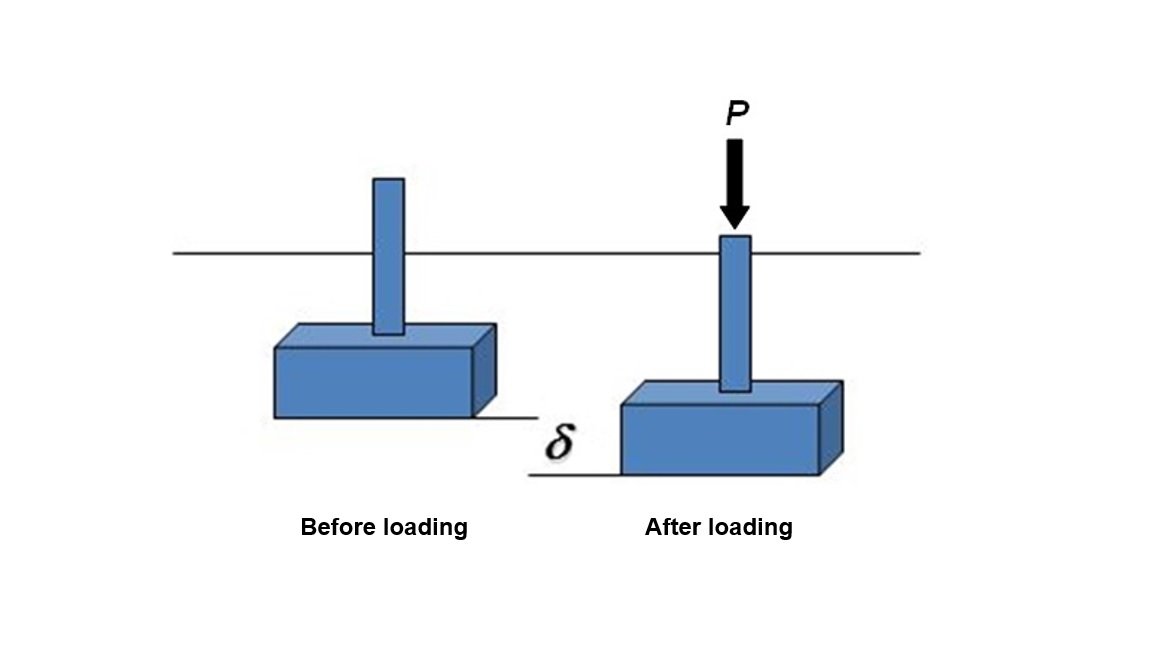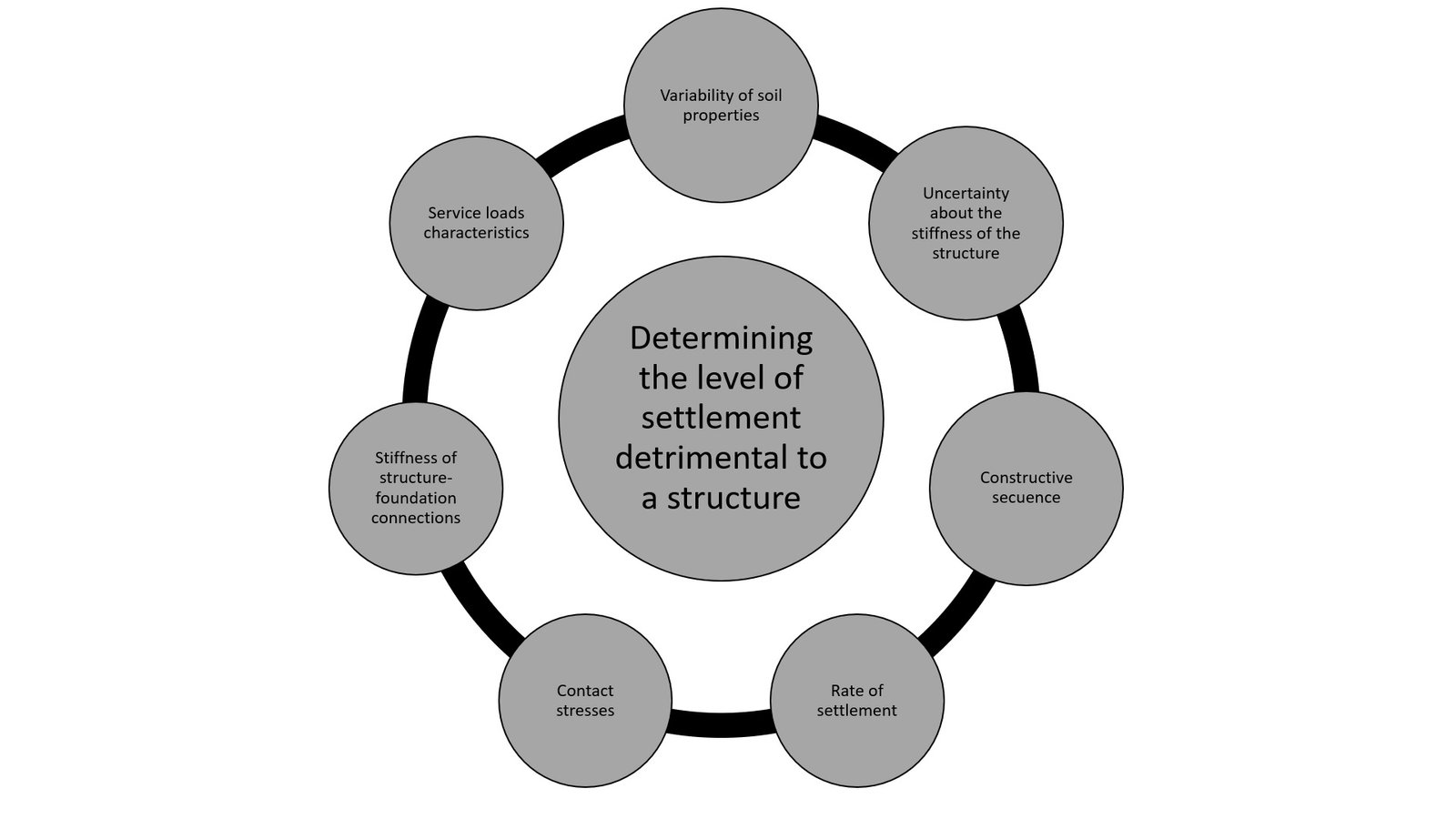

Total allowable foundations settlements
The basic requirements that a foundation must meet are: 1) that it is completely safe against shear failure; and 2) that it does not experience excessive settlements that affect the functionality of the structure. In that context, what is the total allowable settlement for a particular foundation? Read on to find the answer.
Total settlement
What is the total settlement of a foundation? Basically, we can define total settlement (δ) as the change in elevation of a foundation from its original unloaded position to a final position when it is subjected to service stresses. Figure 1 illustrates the concept considering an isolated shallow foundation.

Figure 1 Total settlement (δ) in an isolated shallow foundation
Structures that experience excessive total settlement may suffer some of the following problems (Coduto, 2001):
- Connections with existing structures. Some buildings are usually attached to others, so they must have similar settlements, in order to avoid functionality problems.
- Service lines. Buildings, tanks and other structures, usually are conected to services, most of them located underground. So, if the structure settled, conections with such lines could be fail.
- Surface drains. Typically, the floor of the structures must be at a higher level than the ground, so that rainwater can drain without restrictions. However, if significant settlements occur, drainage patterns may be altered.
- • Accesses. Vehicles and pedestrians may be affected when entering the structure in case of major settlements.
- Aesthetics. Overcrowded settlements can generate aesthetic problems in the structures, characterized by the presence of cracks, which can subsequently lead to structural failures
It is noteworthy that, even with significant total settlements, some structures can still function. Such is the case of certain buildings located in Mexico City, which have experienced settlements up to 2 m!!! In these extraordinary cases, it is likely that the settlement of the building has occurred relatively uniformly in all its foundations, minimizing the effect of differential deformations on the superstructure.
Criteria for total allowable settlements
Although foundations meet the requirements of resistance against collapse, sometimes they may not meet certain requirements of functionality of the structure. At this point, the prediction of expected settlements is a fundamental task of the Foundation Engineer.
However, the determination of the level of settlement that can cause significant structural and architectural damage is an indeterminate analytical problem of considerable complexity, due to the number of factors involved in the problem (see Figure 2). Therefore, the development of a criterion to establish the maximum allowable settlement level has been a task developed empirically, based on observations of settlement and damage in buildings (Holtz, 1991).
Table 1 presents typical values of total allowable design settlements. It is important to mention that these values include a factor of safety, so they should be compared directly with the estimated total settlements.
Table 1 Typical values for total allowable settlements for foundation design (Source: Coduto, 2001)
Structure
| Total allowable settlements (δ) | |
(in) | (mm) | |
Office buildings | 0,5 – 2,0 | 12 – 50 |
Heavy industrial structures | 1,0 – 3,0 | 25 – 75 |
Bridges | 2,0 | 50 |

Figure 2 Factors to be considered in estimation settlements that could affect the funcionality of structures.
Bjerrum (1963) developed a criterion for determining the total allowable settlements (δ), based on the relationship of such deformations to the allowable differential settlements (δD), according to observations made on similar structures supported on similar soil profiles. Figures 3 and 4 summarize the information supporting the criterion proposed by Bjerrum in clayey and sandy soil profiles, respectively.

Figure 3 Total and differential settlements for shallow foundations on clayey soils (Source: adapted from Bjerrum, 1963).

Figure 4 Total and differential settlements for shallow foundations on sandy soils (Source: adapted from Bjerrum, 1963).
The use of the above graphs implies knowing the allowable differential settlement (δD) for the structure under study, data that is usually available at the design stage. In a future post we will deal in detail with this topic, which is fundamental for the design of foundations.
Empirical criteria
In order to carry out preliminary estimates of the total allowable settlement (δ), if the maximum tolerable differential settlement (δD) by a structure is known, it can be considered:
- δ = 2 x δD for clays (Holtz, 1991).
- δ = 1,33 x δD for sands (Terzaghi & Peck, 1967).
In any case, during a geotechnical project the important thing is to predict the magnitude and rate of settlements, considering the function that the structure will fulfill during its useful life. It is vital to ensure that limits are not reached that affect the functionality of the structure, nor generate structural damage to the structure.
References
- Bjerrum, L. (1963) “Allowable Settlements of Structures”. Proceedings of the 3rd European Conference on Soil Mechanics and Foundation Engineering, pp.135-137. Wiesbaden, Germany.
- Coduto, D. (2001) “Foundation Design: Principles and Practices”. Second Edition. Prentice Hall. New Jersey, USA.
- Holtz, R. (1991) “Stress Distribution and Settlement of Shallow Foundations”. Foundation Engineering Handbook. Second Edition. Van Nostrand Reinhold. New York, USA.
- Terzaghi, K. & Peck, R. (1967) “Soil Mechanics in Engineering Practice”. Second Edition. John Wiley & Sons, Inc. New York, USA.